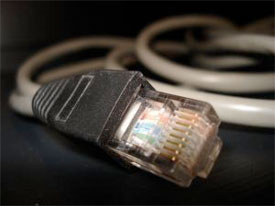LU boosts research data transfer speed 20-fold with NSF grant
 Lamar University’s research community will soon benefit from a 20-fold increase in data transfer speed thanks to a major project funded by a National Science Foundation grant. Through the NSF grant the LU research community will realize up to 10 Gigabits per second (Gbps) speeds, according to Priscilla Parsons, vice president for information technology at LU.
Lamar University’s research community will soon benefit from a 20-fold increase in data transfer speed thanks to a major project funded by a National Science Foundation grant. Through the NSF grant the LU research community will realize up to 10 Gigabits per second (Gbps) speeds, according to Priscilla Parsons, vice president for information technology at LU.
“Productive and innovative scientific, technical and engineering research is increasingly dependent on intensive computational requirements and the use of big data sets,” said LU Provost James Marquart. “These NSF-funded upgrades will greatly enhance Lamar University’s research capabilities and its educational mission. This capability is critical for our faculty to conduct research, secure future research opportunities, and to deliver educational content using big data sets.”
Calling the changes “transformational,” Marquart said it “will strengthen graduate and undergraduate research programs and create opportunities for increased student engagement in intensive computational and data driven research.”
The three-phase project is already well underway, Parsons said, with LU having already made upgrades to the wide area network (WAN) via the Lonestar Education and Research Network (LEARN).
Parsons serves as the principal investigator for the grant “Campus Cyberinfrastructure – Data, Networking, and Innovation Program, Networking Infrastructure: Data Driven Network Infrastructure Upgrade for Lamar University Research.” She is joined by co-principle investigators Peter Kelleher, associate provost for research and sponsored programs, Larry Osborne, professor of computer science, and Patrick Stewart, senior director of infrastructure services.
The second and third phases, which are covered by the $376,917 NSF grant, are to create a Science DMZ and upgrade the local area network (LAN) servicing data-intensive research buildings. The Science DMZ model, which first came into public discussion based on a presentation by researchers Eli Dart and Joe Metzger in 2011, and was expanded on in a publication by Dart, Lauren Rotman, Brian Tierney, Mary Hester and Jason Zurawski at an international conference in Denver in 2013, addresses network performance issues encountered by research institutions and provides a framework to support data-intensive science. The NSF-funded upgrade will also transform LU’s campus capability for research programs by interconnecting research-intensive areas on campus to one another through a 10 Gbps fiber backbone.
“By creating LU’s Science DMZ, research data traffic will no longer be intermingled within the overall university data flows, resulting in a tremendous increase in the bandwidth available for research” Parsons said. The Science DMZ’s 10 Gbps connection to high-speed, high-capacity wide area networks will enable LU’s researchers to efficiently access and transfer data necessary to their high-volume research.
The upgrades will enhance potential opportunities for researchers to connect to state and national high performance computing facilities, including those supported through NSF/XSEDE (Extreme Science and Engineering Discovery Environment).
LU’s IT department will roll out access to the upgraded network backbone to data-intensive research buildings across the campus including Geology, Archer Physics, Chemistry, Cherry Engineering, Lucas Engineering, Hayes Biology, and the Maes Building.
New buildings currently in construction or planning stages including the Reaud Honors College in the Reaud Administration Building, the Center for Innovation, Commercialization and Entrepreneurship, and the future Science and Technology building will also have LAN access to the NSF funded Science DMZ.
“This NSF grant supports an important basic infrastructure that has the potential to broadly benefit faculty research,” Kelleher said. “It also provides for ways to enhance faculty awareness and use of the improved infrastructure.”
A Data Network Users Group will be formed consisting of faculty, students and researchers who have an interest in “Big Data” and have intensive data and computational needs, Kelleher said. There, research faculty, students and invited speakers present and discuss their research programs and handling of “Big Data.” Also, a forum will be held to focus on information to faculty, staff and students about the proposed infrastructure design and potential benefits.
Another forum will provide training and information on the upgrade, Science DMZ, LEARN, and NSF/XCEDE. A third forum will seek feedback from faculty on their use of the Science DMZ and associated upgrades in their research programs.


